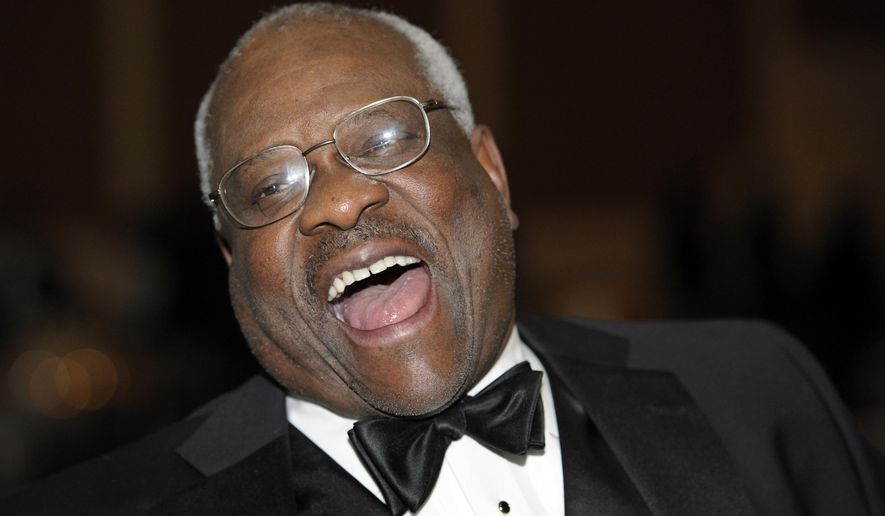By Bradford Richardson - The Washington Times - Updated: 11:07 a.m. on Tuesday, September 26, 2017
Just in time to celebrate its first anniversary, the Smithsonian’s National Museum of African American History and Culture has included a display featuring Justice Clarence Thomas, one of the U.S. Supreme Court’s conservative stalwarts.
Justice Thomas appears in an exhibit that was installed shortly before the one-year anniversary Sunday, a Smithsonian spokeswoman said Monday. The display honors both of the black justices who ascended to the pinnacle of the legal profession. The other is Thurgood Marshall.
Justice Thomas’ apparent omission irked conservative observers, who suspected an ideological bias among Smithsonian officials and called for the influential jurist’s inclusion in the museum.
Ronald D. Rotunda, distinguished professor of jurisprudence at the Dale E. Fowler School of Law at Chapman University, said Justice Thomas deserves to be recognized for his contributions to constitutional jurisprudence, his record of public service and his inspirational life story.
“Like Thurgood Marshall, he has been a very influential justice, and like Thurgood Marshall, he has risen from humble beginnings,” Mr. Rotunda said. “His father left him, his grandparents raised him. The 1968 assassination of Martin Luther King Jr. turned him to the law. He left a successful corporate law practice and turned to public service. That path led him to the Supreme Court.”
Mr. Rotunda said it’s “surprising that it has taken so long” for the museum to acknowledge such a “seminal figure on the U.S. Supreme Court.”
Linda St. Thomas, chief spokeswoman for the Smithsonian Institution, said the exhibit includes a picture of Justice Thomas, the cover of Jet magazine on which he appeared in 1991 and the inscription, “Clarence Thomas: From Seminary School to Supreme Court.”
She said the museum is “evolving and other things will change over time.”
The Smithsonian faced an intense backlash last year over Justice Thomas’ absence from the museum.
Although the museum failed to make mention of the second black man to sit on the U.S. Supreme Court, it found considerable space to recognize the Black Panthers, hip-hop and the Black Lives Matter movement. Even a pin reading “I Believe Anita Hill,” the woman who accused Justice Thomas of sexual harassment during his 1991 Senate confirmation hearing, was included.
Congressional Republicans introduced resolutions in December asking the museum to recognize the “historical importance” of Justice Thomas. Sen. Ted Cruz, Texas Republican, penned a letter to the Smithsonian saying he was “deeply disturbed” by the snub.
The controversy boiled over again last month, when museum curators said gear worn by Colin Kaepernick, the former NFL quarterback who refused to stand for the national anthem before football games last year, would be put on display.
The exclusion of Justice Thomas was a blemish on an otherwise beloved museum.
The Smithsonian’s 19th and most popular institution, the National Museum of African American History and Culture far exceeded attendance expectations, attracting nearly 3 million people in its first year.
“We expected 4,000 people a day,” founding director Lonnie Bunch told The Associated Press. “We get 8,000 people a day, so I can’t complain about a thing.”
To celebrate the one-year anniversary, the museum extended its hours last weekend so more people could get inside to see exhibits designed to take visitors through black American history: from slavery, on the lower level, to a reproduction of Oprah Winfrey’s television set upstairs and artifacts from Barack Obama’s first presidential campaign.
Ground for the $540 million museum was broken in 2012 on a 5-acre tract near the Washington Monument. Construction was completed last year. Millions of donors contributed $315 million in private funds ahead of the opening.
The nation’s first black president, Mr. Obama, opened the museum to a standing-room-only crowd on Sept. 24, 2016, with the ringing of a church bell.
People of all colors and creeds have flocked to the museum to see exhibits including the glass-topped casket used to bury lynching victim Emmett Till, a fedora owned by late pop superstar Michael Jackson and a slave cabin from Edisto Island, South Carolina.
Just as important as the exhibits are the emotions and the memories the museum evokes, Mr. Bunch said. Wandering through the museum, he can often see grandmothers explaining the Jim Crow South to children, and fathers and sons talking about the joys and horrors of growing up in a segregated United States.
“Because you have these collections, it allows people to open up to share stories to find memories. I’ve heard many times people say, ‘I forgot, but once I saw a segregated door or once I saw that washboard it brought back those memories,’” Mr. Bunch said. “So what we wanted has happened. This museum has humanized history.”





No comments:
Post a Comment